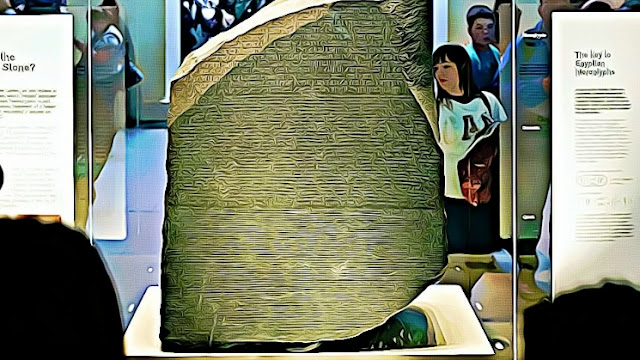"From Stone Spheres to Space Telescopes: The Top 10 Most Unique References in the World", Throughout history, humans have created references to help understand the world around them. From maps to encyclopedias, these references have served as a means to store and transfer knowledge. Some of these references are more unique than others, and in this article, we will explore the 10 most unique references in the world.
1. The Rosetta Stone
The Rosetta Stone is a stone slab discovered in Egypt in 1799, and is one of the most significant archaeological finds in history. It is inscribed with three versions of a decree issued at Memphis in 196 BC. The decree is written in three scripts: Ancient Egyptian hieroglyphs, Demotic script, and Greek script. The Rosetta Stone was the key to deciphering hieroglyphs, as it provided a way to translate them into a known script. Today, the Rosetta Stone is housed in the British Museum in London.
2. The Codex Gigas
The Codex Gigas, also known as the Devil's Bible, is a medieval manuscript that is the largest surviving manuscript in the world. It was created in the 13th century in a Bohemian monastery and is 36 inches tall, 20 inches wide, and weighs 165 pounds. The Codex Gigas contains the entire Latin Bible, as well as several other works, including medical texts, historical texts, and magical formulas. The manuscript is known for its illustrations, which include a full-page portrait of the Devil.
3. The Voynich Manuscript
The Voynich Manuscript is a mysterious book that has confounded scholars for centuries. It is written in an unknown script and includes strange illustrations of plants, animals, and human figures. The manuscript was discovered in Italy in the 16th century, and despite numerous attempts to decipher it, its meaning remains a mystery. Some scholars believe that the Voynich Manuscript is a medieval herbal, while others think it may be a coded message.
4. The Antikythera Mechanism
The Antikythera Mechanism is an ancient Greek astronomical device that is considered the world's oldest computer. It was discovered in 1901 in the Antikythera shipwreck and dates back to the 2nd century BC. The mechanism was used to predict the positions of the sun, moon, and planets, as well as to track lunar and solar eclipses. The Antikythera Mechanism is an impressive feat of ancient engineering and has provided insight into the sophistication of ancient Greek technology.
5. The Stone Spheres of Costa Rica
The Stone Spheres of Costa Rica are a collection of over 300 stone spheres that were created by the ancient inhabitants of the region. The spheres range in size from a few inches to over 8 feet in diameter and are made of a variety of rocks, including granite and sandstone. The purpose of the spheres is unknown, but they are believed to have been used for astronomical purposes or as a symbol of status.
6. The Great Wall of China
The Great Wall of China is a series of fortifications that were built in ancient China to protect against invaders. The wall stretches over 13,000 miles and was constructed over several centuries. The Great Wall is a remarkable feat of engineering and has become one of China's most famous landmarks.
7. The Nazca Lines
The Nazca Lines are a series of ancient geoglyphs located in the Nazca Desert of southern Peru. The lines were created by removing the dark reddish-brown iron oxide-coated pebbles that cover the surface of the Nazca desert and revealing the light-colored earth underneath. The Nazca Lines depict various animals, plants, and geometric shapes and are best viewed from the air. The purpose of the Nazca Lines is still unknown, but some theories suggest they were used for astronomical or religious purposes.
8. The Svalbard Global Seed Vault
The Svalbard Global Seed Vault is a secure seed bank located on the Norwegian island of Spitsbergen. The vault was created to preserve and protect the world's crop diversity in case of a global disaster. It stores over a million seed samples from around the world, including rare and endangered plant species. The vault is designed to withstand natural and man-made disasters, and its location in the Arctic makes it an ideal location for long-term seed storage.
9. The Hubble Space Telescope
The Hubble Space Telescope is a telescope that orbits the Earth and has revolutionized our understanding of the universe. It was launched into orbit in 1990 and has captured images of galaxies, stars, and other celestial bodies. The Hubble has provided insights into the age and size of the universe, the formation of galaxies, and the existence of dark matter. Its images have also inspired awe and wonder in people around the world.
10. The Internet
The Internet is a vast network of interconnected computers and devices that has transformed the way we communicate and access information. It has revolutionized industries, such as communication, commerce, and entertainment, and has enabled people to connect with others from all over the world. The Internet has also facilitated the sharing of knowledge and has provided people with access to information that was once inaccessible.
In conclusion, these 10 unique references have all had a significant impact on our understanding of the world around us. From ancient artifacts to modern technology, these references have provided insights into the past, present, and future. They have also inspired wonder and awe, and have challenged us to question our assumptions and explore the unknown.
